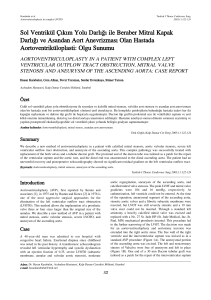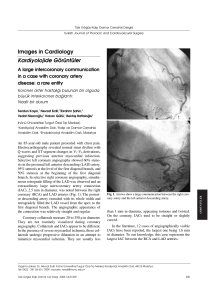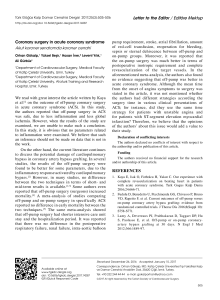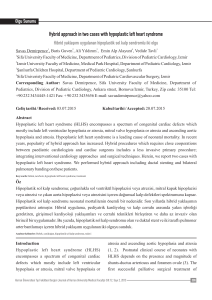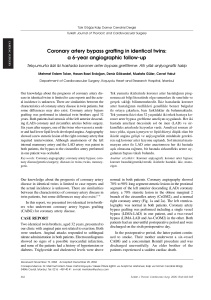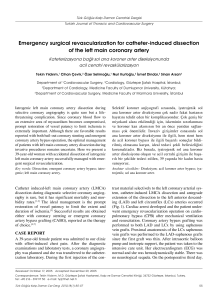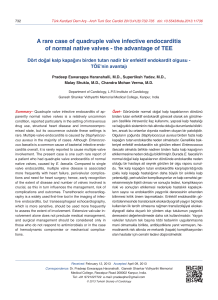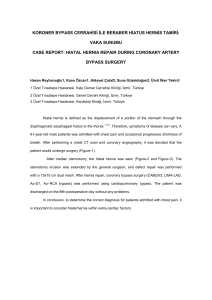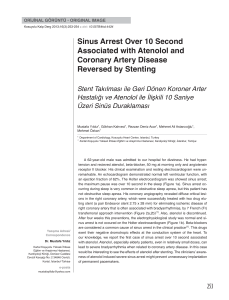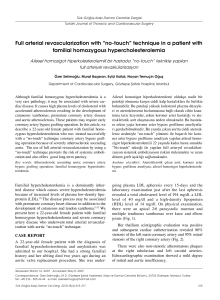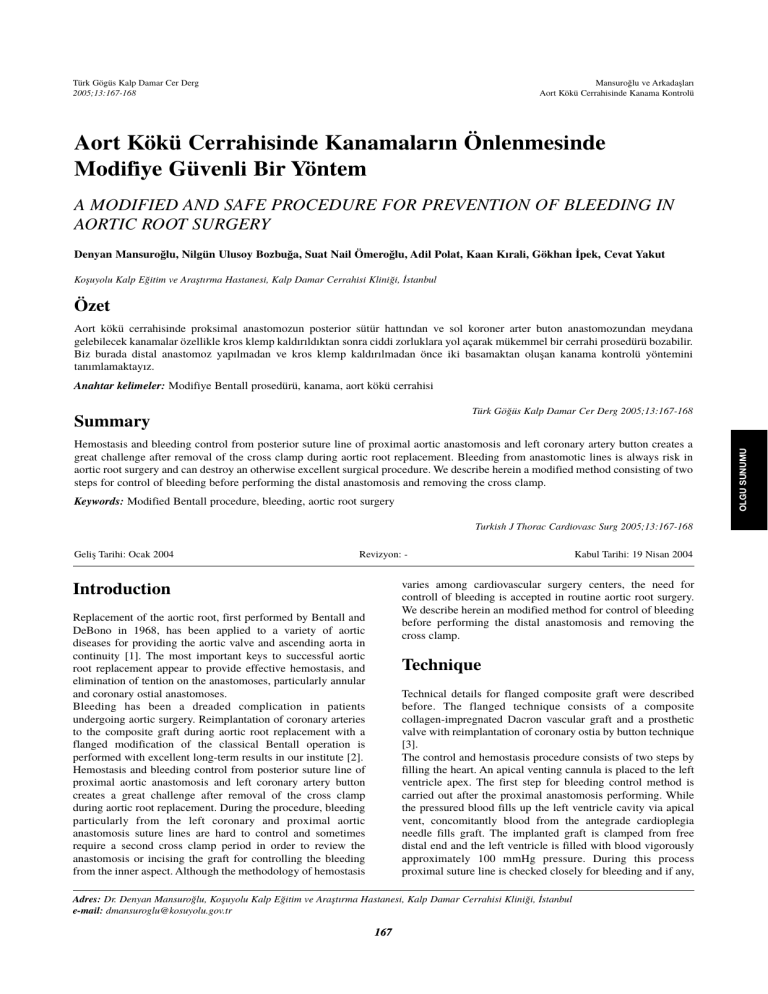
Türk Gögüs Kalp Damar Cer Derg
2005;13:167-168
Mansuro¤lu ve Arkadafllar›
Aort Kökü Cerrahisinde Kanama Kontrolü
Aort Kökü Cerrahisinde Kanamalar›n Önlenmesinde
Modifiye Güvenli Bir Yöntem
A MODIFIED AND SAFE PROCEDURE FOR PREVENTION OF BLEEDING IN
AORTIC ROOT SURGERY
Denyan Mansuro¤lu, Nilgün Ulusoy Bozbu¤a, Suat Nail Ömero¤lu, Adil Polat, Kaan K›rali, Gökhan ‹pek, Cevat Yakut
Kofluyolu Kalp E¤itim ve Araflt›rma Hastanesi, Kalp Damar Cerrahisi Klini¤i, ‹stanbul
Özet
Aort kökü cerrahisinde proksimal anastomozun posterior sütür hatt›ndan ve sol koroner arter buton anastomozundan meydana
gelebilecek kanamalar özellikle kros klemp kald›r›ld›ktan sonra ciddi zorluklara yol açarak mükemmel bir cerrahi prosedürü bozabilir.
Biz burada distal anastomoz yap›lmadan ve kros klemp kald›r›lmadan önce iki basamaktan oluflan kanama kontrolü yöntemini
tan›mlamaktay›z.
Anahtar kelimeler: Modifiye Bentall prosedürü, kanama, aort kökü cerrahisi
Hemostasis and bleeding control from posterior suture line of proximal aortic anastomosis and left coronary artery button creates a
great challenge after removal of the cross clamp during aortic root replacement. Bleeding from anastomotic lines is always risk in
aortic root surgery and can destroy an otherwise excellent surgical procedure. We describe herein a modified method consisting of two
steps for control of bleeding before performing the distal anastomosis and removing the cross clamp.
Keywords: Modified Bentall procedure, bleeding, aortic root surgery
Turkish J Thorac Cardiovasc Surg 2005;13:167-168
Gelifl Tarihi: Ocak 2004
Revizyon: -
Kabul Tarihi: 19 Nisan 2004
varies among cardiovascular surgery centers, the need for
controll of bleeding is accepted in routine aortic root surgery.
We describe herein an modified method for control of bleeding
before performing the distal anastomosis and removing the
cross clamp.
Introduction
Replacement of the aortic root, first performed by Bentall and
DeBono in 1968, has been applied to a variety of aortic
diseases for providing the aortic valve and ascending aorta in
continuity [1]. The most important keys to successful aortic
root replacement appear to provide effective hemostasis, and
elimination of tention on the anastomoses, particularly annular
and coronary ostial anastomoses.
Bleeding has been a dreaded complication in patients
undergoing aortic surgery. Reimplantation of coronary arteries
to the composite graft during aortic root replacement with a
flanged modification of the classical Bentall operation is
performed with excellent long-term results in our institute [2].
Hemostasis and bleeding control from posterior suture line of
proximal aortic anastomosis and left coronary artery button
creates a great challenge after removal of the cross clamp
during aortic root replacement. During the procedure, bleeding
particularly from the left coronary and proximal aortic
anastomosis suture lines are hard to control and sometimes
require a second cross clamp period in order to review the
anastomosis or incising the graft for controlling the bleeding
from the inner aspect. Although the methodology of hemostasis
Technique
Technical details for flanged composite graft were described
before. The flanged technique consists of a composite
collagen-impregnated Dacron vascular graft and a prosthetic
valve with reimplantation of coronary ostia by button technique
[3].
The control and hemostasis procedure consists of two steps by
filling the heart. An apical venting cannula is placed to the left
ventricle apex. The first step for bleeding control method is
carried out after the proximal anastomosis performing. While
the pressured blood fills up the left ventricle cavity via apical
vent, concomitantly blood from the antegrade cardioplegia
needle fills graft. The implanted graft is clamped from free
distal end and the left ventricle is filled with blood vigorously
approximately 100 mmHg pressure. During this process
proximal suture line is checked closely for bleeding and if any,
Adres: Dr. Denyan Mansuro¤lu, Kofluyolu Kalp E¤itim ve Araflt›rma Hastanesi, Kalp Damar Cerrahisi Klini¤i, ‹stanbul
e-mail: [email protected]
167
OLGU SUNUMU
Türk Gö¤üs Kalp Damar Cer Derg 2005;13:167-168
Summary
Mansuro¤lu et al
Prevention of Bleeding in Aortic Root Surgery
Turkish J Thorac Cardiovasc Surg
2005;13:167-168
described before [4]. According to our point of view, we do not
need the heart contracting spontaneously and moreover, we can
control the suture lines with a near normal antegrade
physiology with the any pressure possible. The reducing
venous return to the pump for few seconds can provide to
accomplish left ventricular filling. But this method do not form
enough pressure in left ventricle to control the bleeding from
the proximal suture line. Although the using of apical vent for
controlling can be thougth troublesome, this approach is the
only filling way to obtain with physiological pressure into the
left ventricle. The limitation of this technique, particularly in
the former step for proximal anastomosis, is the presence of
mitral regurgitation. In case of significant mitral regurgitation,
mitral valve should already be either repaired or replaced
before aortic root procedure.
Any bleeding that may be seen after removal of the cross clamp
shall be prevented in this way. A second cross clamp period,
revision of the proximal anastomosis or incision of the graft for
bleeding control may be prevented. This will decrease the
perfusion period and use of blood and blood products. Another
advantage for the latter step for the left button anastomosis is
determination of the button site as the graft is filled in order to
prevent further distention and distorsion at this site.
This new technique provides secure controlling and preventing
excess bleeding from the root. Our technique is effective,
physiologic and practic to lessen bleeding and additional
maneuvers for controll. Moreover, this technique can easily be
performed by any surgeon with no additional risk to the patient.
contolled with separate 4/0 prolene suture.
Left coronary anastomosis site is determined as the graft is
filled and performed with 6/0 prolene suture. The second step
for bleeding control is carried out after completing the left
coronary button implantation. The composite graft is filled via
antegrade cardioplegia needle on the graft and the left coronary
button is checked for bleeding and controlled with 6/0 prolene
suture. Right coronary anastomosis site is determined and
anastomosis is performed following the steps described as left
coronary button. Clamp on the graft is removed and the
procedure is succeded as the distal anastomosis is done with
4/0 prolene suture. After filling and deairing the heart; aortic
cross clamp is removed, distal anastomosis is controlled for
bleeding and the remaining process is performed in a
standardized fashion.
Discussion
CASE REPORT
For better morphological basis of Bentall procedure and
reducing the incidence of complications, a modified flanged
technique has been suggested and succesfully used at
Kosuyolu Heart and Research Hospital [3]. The original
technique has been modified for reducing major hemorrhage
and leakage from the composite graft and preventing
pseudoaneurysm formation at suture lines and progression of
aneurysm and/or dissection in the remaining aortic segment,
especially in patients with Marfan's syndrome or in patients
with aortic dissection. This new technique also provides
flexible and secure part of aortic continuity by preventing
excess bleeding and narrowing of the root.
But bleeding is still a serious problem for both patient and
surgeon in Bentall and its modifications [4]. Bleeding from
anastomotic lines is always risk in aortic root surgery and can
destroy an otherwise excellent surgical procedure. Previous
research for uncontrolled bleeding was done and shunt
techniques for classical Bentall procedure were described.
Although these complications were lessened with advanced
graft making, bleeding from the posterior suture line of
proximal anastomosis and the left coronary button are still
challenging issues for the surgeon. A succesful method for
bleeding control by having heart filled and contract
spontaneously by warm retrograde blood cardioplegia was
References
1. Bentall H, DeBono A. A technique for complete
replacement of the ascending aorta. Thorax 1968;23:338-9.
2. Kirali K, Mansuro¤lu D, Ömero¤lu SN, et al. Five-year
experience in aortic root replacement with the flanged
composite graft. Ann Thorac Surg 2002:73:1130-7.
3. Yakut C. A new modified Bentall procedure: The Flanged
Technique. Ann Thorac Surg 2001;71:2050-2.
4. Karamanoukian HL, Dancona G, Ricci M, Bergsland J,
Salerno TA. Prevention of bleeeding in aortic root surgery.
J Card Surg 1999;14:390-1.
168


